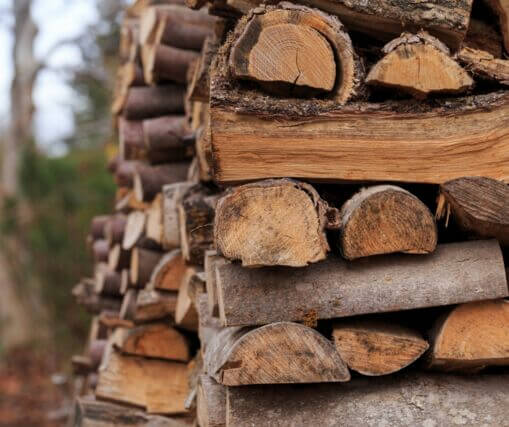New to heating with wood? That’s where we come in! Enjoy the warming glow of your wood stove all winter long by taking the steps necessary to ensure your firewood is prepared to burn. From seasoning your firewood to storing it away for the winter months, we are here to guide you every step of the way so you can enjoy the efficient warmth of your wood stove.
Why is it Important to Use Dry Wood?
Wood that has not been seasoned, or what many call “green wood,” is the main culprit to an inefficient burn. Because of its high moisture content, green wood produces plumes of smoke, wreaking havoc on your stove, venting, the atmosphere and even your health, making it all the more important to plan ample time to season your firewood.
How to Tell When Firewood is Ready to Burn
There are multiple ways that you can tell your firewood is ready to burn. While some include additional instruments, such as a moisture meter, other tests rely on the look, feel and sound of your firewood. Here are the best indicators your firewood is properly seasoned:
Moisture Meter
The most reliable of all the tests you can conduct, measuring the moisture content is a simple way to ensure your wood is dry enough for use. To use a moisture meter, you will first split the wood, then insert the probe ¼ inch down into the freshly split side. Firewood that is ready to burn will have 20% or lower moisture content.
Color
When chopping and stacking your firewood, take note of its initial color. This will serve as a baseline in comparison to months down the road after drying out. Once you notice your firewood’s initial deep hues are turning to light tan or grey in color, this is a good indicator that your firewood is seasoned. The less moisture content in wood, the lighter in color it becomes.
Sound
There is also a difference in sound between seasoned and unseasoned wood. Dry wood will make a solid, crackling sound when you hit one against another, whereas wood with high moisture content will make a thudding sound.
Feel
The feel of the wood as compared to when you first chopped it is another good indicator. When wood is first chopped, the bark is solid, and the wood is heavier. As the wood dries out, it will become lighter, and you will notice the bark start to flake off.
How to Season and Store Firewood
Ensuring perfect dry, seasoned wood is all in the planning. If you are using softwoods such as fir, cedar, spruce and alder, chop and stack the firewood at least six months before you plan to use it. On the other hand, if you are using hardwoods such as oak, ash, birch and cherry, plan at least one or two years ahead of time.
Normally, most wood stove owners chop and stack wood in the spring months and use the summer sun to help dry out the wood to use in the fall and winter months. With these steps, you will enjoy a hearty supply of firewood ready to burn when the cold approaches.
Chopping Firewood
Smaller chunks of wood dry out faster than logs. As a general rule of thumb, you will want to chop the wood so it is 16 inches long and six inches thick. However, this can change depending on the size of your stove.
By splitting the firewood, you are creating more surface area to reach the sun and wind, which are key factors in drying out your firewood.
Stacking Firewood
After chopping your firewood, you will want to find a dry area outside to stack it, preferably in the sunlight. Be sure to provide enough air circulation to prevent mold from forming, including at the base. Stack the firewood in a crisscross pattern to promote airflow and keep the bark facing upwards to protect the exposed flesh of the wood from any rainwater or other moisture. For particularly rainy days, you can cover your stack with a tarp.
Pro-Tip: Do not stack directly on the ground. It is best to keep your wood stack elevated to prevent any of the wood from rotting or producing mold. You can elevate your stack by building a base of wooden pallets or building a wood or metal structure to house your firewood.
Storing Firewood
After drying your firewood, it is ready to be stored for future use. Be sure to store your firewood at least five feet away from your home to prevent any critters that may be hiding in it from getting into your home. Stored firewood can last up to four years if properly protected from the elements.
There you have it! By properly planning and preparing your firewood, you will be able to enjoy the rolling fire of your wood stove all winter. If you are new to the world of owning a wood stove, we recommend brushing up on some of our expert recommendations to extract the most value out of your wood stove.


